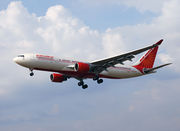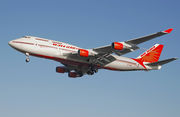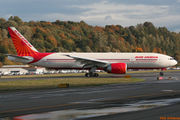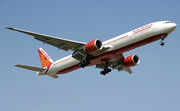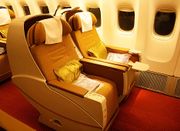Air India
 |
||||
|
||||
| Founded | July 1932 (as Tata Airlines) | |||
|---|---|---|---|---|
| Commenced operations | 15 October 1932 | |||
| Hubs | ||||
| Secondary hubs | ||||
| Focus cities | ||||
| Frequent-flyer program | Flying Returns | |||
| Member lounge | Maharaja Lounge | |||
| Alliance | Star Alliance (March 2011) | |||
| Subsidiaries |
|
|||
| Fleet size | 31 (+ 30 orders) | |||
| Destinations | 29 (excl. subsidiaries) | |||
| Company slogan | "Your Palace in the Sky" | |||
| Parent company | NACIL | |||
| Headquarters | Air India Building, Nariman Point, Mumbai, Maharashtra, India |
|||
| Key people | J. R. D. Tata, Founder Arvind Jadhav, CMD |
|||
| Website | www.airindia.com | |||
Air India (Hindi: एअर इंडिया) is a state-owned flag carrier of the Republic of India. It operates a fleet of Airbus and Boeing aircraft serving Asia, Europe and North America. It is India's oldest and largest airline. Its corporate office is located at the Air India Building at Nariman Point in South Mumbai. It is the 16th largest airline in Asia.
Air India has two major domestic hubs at Delhi and Mumbai respectively and one international hub at Frankfurt. London acts as a focus city for the airline.
Star Alliance announced on 13 December 2007 that it had invited Air India to join as a member.[1][2] Air India is set to become a full Star Alliance member by March 2011.[3]
Air India is a part of the Indian government-owned National Aviation Company of India Limited (NACIL).
Contents |
History


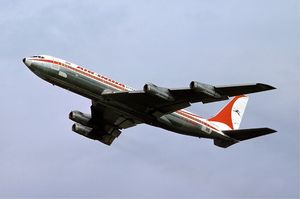

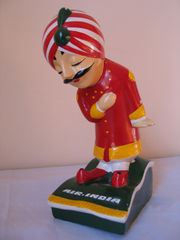
Early years
Air India was founded by J. R. D. Tata in July 1932 as Tata Airlines, a division of Tata Sons Ltd. (now Tata Group). On 15 October 1932, J. R. D. Tata flew a single-engined De Havilland Puss Moth carrying air mail (postal mail of Imperial Airways) from Karachi's Drigh Road Aerodrome to Bombay's Juhu Airstrip via Ahmedabad. The aircraft continued to Madras via Bellary piloted by former Royal Air Force pilot Nevill Vintcent.
Post-war expansion
Following the end of World War II, regular commercial service was restored in India and Tata Airlines became a public limited company on 29 July 1946 under the name Air India. In 1948, after the Independence of India, 49% of the airline was acquired by the Government of India, with an option to purchase an additional 2%. In return, the airline was granted status to operate international services from India as the designated flag carrier under the name Air India International. On 8 June 1948, a Lockheed Constellation L-749A named Malabar Princess (registered VT-CQP) took off from Bombay bound for London via Cairo and Geneva. This marked the airline's first long-haul international flight, soon followed by service in 1950 to Nairobi via Aden.
On 1 August 1953, the Government of India exercised its option to purchase a majority stake in the carrier and Air India International Limited was born as one of the fruits of the Air Corporations Act that nationalised the air transportation industry. At the same time all domestic services were transferred to Indian Airlines. In 1954, the airline took delivery of its first L-1049 Super Constellations and inaugurated services to Bangkok, Hong Kong, Tokyo and Singapore.
The Jet age
Air India International entered the jet age in 1960 when its first Boeing 707-420, named Gauri Shankar (registered VT-DJJ), was delivered. Jet services to New York City via London were inaugurated that same year on 14 May 1960. On 8 June 1962, the airline's name was officially truncated to Air India. On 11 June 1962, Air India became the world's first all-jet airline.
In 1971, the airline took delivery of its first Boeing 747-200B named Emperor Ashoka (registered VT-EBD). This coincided with the introduction of the 'Palace In The Sky' livery and branding. A feature of this livery is the paintwork around each aircraft window, in the cusped arch style of windows in Indian palaces. In 1986 Air India took delivery of the Airbus A310-300; the airline is the largest operator of this type in passenger service. In 1988, Air India took delivery of two Boeing 747-300Ms in mixed passenger-cargo configuration.
Early 1990s
In 1993, Air India took delivery of the flagship of its fleet when the first Boeing 747-400 named Konark (registered VT-ESM) made history by operating the first non-stop flight between New York City and Delhi. In 1994 the airline was registered as Air India Ltd. In 1996, the airline inaugurated service to its second US gateway at O'Hare International Airport in Chicago. In 1999, the airline opened its dedicated Terminal 2-C at the renamed Chhatrapati Shivaji International Airport in Mumbai.
2000s to Present
In 2000, Air India introduced services to Shanghai and to its third US gateway at Newark Liberty International Airport in Newark. In May 2004, Air India launched a wholly-owned low cost airline called Air-India Express. Air India Express connecting cities in India with the Middle East, Southeast Asia and the Subcontinent. In 2004 Air India launched flights to its fourth US gateway at Los Angeles International Airport in Los Angeles (which has since been terminated) and expanded its international routes to include flights from Ahmedabad, Amritsar, Bangalore and Hyderabad.
On 1 December 2009, Air India introduced services to its fifth US gateway at Washington Dulles International Airport in Washington, D.C., accessed via a stopover at JFK Airport in New York City. This service has been terminated indefinitly without further notifications.
Re-privatisation plans
In 2001, Air India was put up for sale by the then NDA government.[4] One of the bids was by a consortium of Tata Group-Singapore Airlines. However the re-privatisation plans were shelved after Singapore Airlines pulled out and the global economy slumped.[5]
Merger with Indian Airlines
In 2007, the Government of India announced that Air India would be merged with Indian Airlines. As part of the merger process, a new company called the National Aviation Company of India Limited (NACIL) was established, into which both Air India (along with Air India Express) and Indian Airlines (along with Alliance Air) will be merged.
In 2006, the Indian government ordered 111 aircraft from Boeing and Airbus.[6]
Financial crisis
Around 2006-2007, the airlines began showing signs of financial distress. The combined losses for Air India and Indian Airlines in 2006-07 were ![]() 770 crores (
770 crores (![]() 7.7 billion). After the merger of the airlines, this went up to
7.7 billion). After the merger of the airlines, this went up to ![]() 7,200 crores (
7,200 crores (![]() 72 billion) by March 2009.[7] This was followed by restructuring plans which are still in progress.[8] In July 2009, SBI Capital Markets Ltd was appointed to prepare a road map for the recovery of the airline.[9] The carrier sold three Airbus A300 and one Boeing 747-300M in March 2009 for $18.75 million to survive the financial crunch.[10]
72 billion) by March 2009.[7] This was followed by restructuring plans which are still in progress.[8] In July 2009, SBI Capital Markets Ltd was appointed to prepare a road map for the recovery of the airline.[9] The carrier sold three Airbus A300 and one Boeing 747-300M in March 2009 for $18.75 million to survive the financial crunch.[10]
Air India's corporate headquarters is located at the Air India Building at Nariman Point in South Mumbai. The airline moved there in 1970. The Air India Building also serves as a regional office for Indian Airlines.
Delhi Hub
On 1 March 2009, Air India made Frankfurt Airport at Frankfurt am Main as its international hub for onward connections to United States from India. However on July 14th, 2010 Air India chief, Arvind Jadhav announced their intention to make the new terminal 3 at Delhi's Indira Gandhi International Airport the hub for international and domestic operations with the plans of starting new direct flights to Melbourne, Chicago and Toronto and also taking almost all international long haul flights away from its former Primary hub at Mumbai's Chhatrapati Shivaji International Airport due to lack of space.[11] This would also provide greater convenience for transit passengers who before had to transfer between the international and domestic terminals which were located on completely different sides of the airport. They will now be able to catch their connecting flights within the same terminal.
Return to Profitability Plans
The new Chairman and Managing director wants to change the order of some of the 111 planes ordered in 2006 to get narrow-body aircraft instead of the wide-body aircraft.[6]
Corporate Affairs and Identity

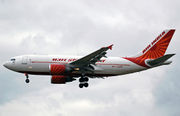
Organization
Air India has two subsidiaries and two affiliated carries. Together Air India, Air India Cargo, Air-India Express, Indian Airlines and Air India Regional form the National Aviation Company of India Limited.
Subsidiaries
Air India Cargo
In 1954, Air India Cargo started its freighter operations with a Douglas DC-3 Dakota aircraft, giving Air India the distinction of being the first Asian airline to operate freighters. The airline operates cargo flights to many destinations. The airline also has ground truck-transportation arrangements on select destinations.
A member of IATA, Air India carries all types of cargo including dangerous goods (hazardous materials) and live animals, provided such shipments are tendered according to IATA Dangerous Goods Regulations and IATA Live Animals Regulations.
At the warehouse in Mumbai, Air India has developed a system of inventory management for cargo handling of import/export functions. This takes care of the entire management of cargo, supports Electronic Data Interface (EDI) messages with Indian Customs and replaces to a great extent existing paper correspondence between Customs, Airlines, and the custodians. This also replaces manual handling and binning of cargo at the warehouse in Mumbai by Air India.
Air-India Express
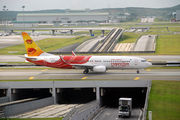
Air-India Express is the airline's low-cost subsidiary which was established in 2005 during the aviation boom in India. It operates scheduled passenger services primarily to the Gulf and South East Asia. Air-India Express is currently the only airline in NACIL which posts profits. It operates a fleet of Next Generation Boeing 737-800 aircraft.
Affiliated Carriers
Indian Airlines
Indian Airlines which is based in Delhi and focuses primarily on domestic routes, along with several international services to neighbouring countries in Asia
Air India Regional
Air India Regional (formerly known as Alliance Air) serves mainly on Regional routes. Its main hub is Delhi's Indira Gandhi International Airport.
Livery
1970-2007 Livery
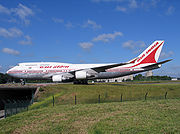
Air India's livery was mostly painted in red and white colours. The bottoms of the aircraft remain metal and unpainted but the upper portion is given a white background along with the airline's name written in red. The name is in Hindi on one side and in English on the other. The painted on red palace style carvings on the outside of the windows refer to their slogan "your palace in the sky" which is written on the back of the aircraft. Near the noses of Air India aircraft, the air plane is given a name. Most planes are named after powerful Indian kings or landmarks. Finally, the tail is mostly red with again, the carrier's name written in Hindi on one side and English on the other.
In 1989, to supplement its "Flying Palace" livery, Air India introduced a new "sun" livery that was mostly white with a golden sun on a red tail. Only applied to around a half of Air India's fleet, the new livery did not succeed, as the Indian flying public complained about the phasing out of the classic colours. The livery was dropped after two years and the old scheme was returned.
Pre-merger Livery
On 15 May 2007, Air India refreshed its livery, making the Rajasthani arches along the windows slightly smaller, extending a stylized cheatline from the vertical tail of the aircraft to the nose, and painting a small portion of the underbelly red. Additionally, engine nacelles are now deep red, and a gold-colored version of the airline's stylized Konark trademark now adorns both the vertical tail and engine nacelles.
Post-merger Livery
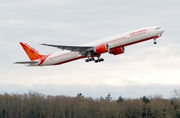
On May 22, 2007, Air India and Indian Airlines unveiled their new livery. The logo of the new airline is a Flying Swan with the Konark Chakra placed inside it. The Flying Swan has been morphed from Air India’s characteristic logo, ‘The Centaur’ whereas the ‘Konark Chakra’ is reminiscent of Indian’s logo.
The new logo features prominently on the tail of the aircraft. Individually the Konark Chakra also features on all the engines of the aircraft. The choice of colours namely red for “Flying Swan” and orange for “Konark Chakra” are meant to signify vigour and advancement. Further the colours also have a strong association with two carriers thereby retaining the earlier imagery of traditional hospitality and service.
While the aircraft is ivory in colour, the base retains the red streak of Air India. Running parallel to each other is the Orange and Red speed lines from front door to the rear door, subtly signifying the individual identities merged into one. The brand name ‘Air India’ runs across the tail of the aircraft in hindi.
Destinations
Air India serves 11 domestic destinations and 18 international destinations in 11 countries across Asia, Europe and North America.
Short-haul routes
Air India's short-haul routes mainly include domestic cities and cities in South East Asia and South West Asia. For short-haul routes its Airbus A310, Airbus A330, Boeing 747-400 and Boeing 777-200/-200ER are used apart from Airbus A320 family aircraft of Indian Airlines which are operated with Air India callsign and code.
Long-haul routes
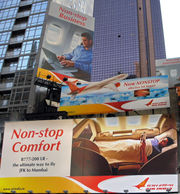
The airline has long-haul destinations in East Asia, Europe and North America which are served using Boeing 777-200LR/-300ER aircraft. Its non-stop Mumbai-New York City route operated on a Boeing 777-200LR is the longest route originating out of India.
Frankfurt Airport in Germany acts as a scissors hub to provide onward Trans-Atlantic connections to the United States. However, Air India will terminate its scissors hub operation at Frankfurt by October 30, leaving only one daily flight to Delhi.
Since the early 1960s, London always has been a major focus city for Air India right from the time when it launched its first Trans-Atlantic services.
Air India has codesharing agreements with the following airlines:[12][13]
|
|
^^ Star Alliance members
With Air India's own entry into the Star Alliance (SA) expected in March 2011,[14] all other codeshare agreements with non-Star Alliance partners may be terminated.[15]
Services
Flying Returns

Flying Returns is Air India's frequent flyer programme. The programme is also shared by Indian Airlines and all other NACIL carriers.
Maharaja Lounge
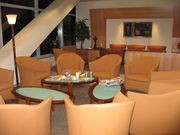
Maharaja Lounge means "Emperor's Lounge", and is offered to First and Business class passengers. Air India shares lounges with other international airlines at international airports that do not have a Maharaja Lounge available. There are five[16] Maharaja Lounges, one at each of the five major destinations of Air India, which are as following:
- India
- International
Fleet
Current Fleet
Air India fleet as of 1 August 2010[17]:
| Aircraft | In service | Orders | Passengers (First/Business/Economy) |
||
|---|---|---|---|---|---|
| Airbus A310-300 | 4 | – | 201 (0/20/181) | ||
| Airbus A330-200 | 2 | – | 279 (0/24/255) | ||
| Boeing 747-400 | 5 | – | 423 (12/26/385) | ||
| Boeing 777-200LR | 8 | 238 (8/35/195) | |||
| Boeing 777-300ER | 12 | 3 | 342 (4/35/303) | ||
| Boeing 787-8 | – | 27 | ??? (0/??/???) | ||
| Total | 31 | 30 | |||
Fleet info
The Boeing customer code for Air India is 7x7-x37 and 7x7-xHG for Air-India Express. As of May 2010, the average age of the Air India fleet is 9.5 years.
New aircraft orders
- On 11 January 2006, Air India announced an order for Sixty Eight jets - eighteen* Boeing 737-800, eight Boeing 777-200LR Worldliners, fifteen Boeing 777-300ER and twenty seven Boeing 787-8 Dreamliners
- Air India received its first ordered Boeing 737-800 aircraft for Air-India Express on 30 November 2006.
- The airlines received its first Boeing 777-200LR aircraft on 26 July 2007 and Boeing 777-300ER on 10 October 2007.
- In April 2010, the airline planned to cancel three Boeing 777-300ERs. Boeing has reportedly offered ten Boeing 737 Next Generation as a substitute for three 777-300ERs.
- Air India will get its first Boeing 787 Dreamliner in 2011.
*One 737-800 crashed in May 2010
Retired Fleet
Air India previously operated the following aircraft types.[19][20][21]
- Airbus A300B4-200 (1982–2002)
- Boeing 707-420 (1961-1988)
- Boeing 707-300B (1964–1988)
- Boeing 737-800 (1998-2007)
- Boeing 747-200B (1971–2007)
- Boeing 757-200 (2007-2007)
- Boeing 767-300ER (2006–2008)
- Boeing 777-200 (2006-2010)
- Boeing 777-200ER (2004-2010)
- Lockheed L-749 Constellation (1932-1947)
- Lockheed L-1049 Super Constellation (1947-1961)
- Lockheed L-1011 TriStar (1995–1996)
- Ilyushin Il-62M (1987-1999)
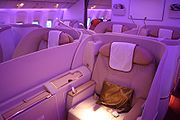
In-Flight Entertainment
Air India's Boeing 777-200LR/-300ER as well as some refurbished Boeing 747-400 aircraft use the Thales TopSeries IFE systems[22] for onboard in-flight entertainment. Airbus A310s do not have personal LCD screens. Airbus A330s have widescreen displays in Business and Economy classes but no personal IFEs.
Awards and recognitions
- Preferred International Airline award for travel and hospitality from Awaz Consumer Awards 2006 [23]
- Best International West Bound Airline out of India for three successive years by Galileo Express TravelWorld Award
- Best Corporate Social Responsibility Initiative. by Galileo Express TravelWorld Award [24]
- Best Short-Haul International Airline by Galileo Express TravelWorld Award 2008[24]
- The Mercury Award for the years 1994 and 2003, from the International Flight Catering Association, for finest in-flight catering services.
- Amity Corporate Excellence Award instituted by the Amity International Business School, Noida, Uttar Pradesh to honour Corporates with distinct vision, innovation, competitiveness and sustenance.[24]
- Reader’s Digest Trusted Brand Award[24]
- Dun and Bradstreet Award(D&B)- first in terms of revenue out of the top airline companies out of India[24]
- Best South Asian Airline award by readers of TTG Asia, TTG China, TTG Mice and TTG-BT Mice China, all renowned Mice and business travel publications.[24]
- Cargo Airline of the Year at the 26th Cargo Airline of the Year Awards[25]
- The airline entered the Guinness Book of World Records for the most people evacuated by a civil airliner. Over 111,000 people were evacuated from Amman to Mumbai – a distance of 4,117 km, by operating 488 flights in association with Indian Airlines, from 13 August to 11 October 1990 – lasting 59 days. The operation was carried out during Persian Gulf War in 1990 to evacuate Indian expatriates from Kuwait and Iraq.[26]
- The Montreal Protocol Public Awareness Award was awarded to Air India by the United Nations for environmental protection, especially in the ozone layer.[27]
- World's first all-jet airline- June 1962
- World's largest operator of Airbus A310-300
- Air India's security department became the first aviation security organisation in the world to acquire ISO 9002 certification (31 January 2001).
- Air India's Department of Engineering has obtained the ISO 9002 for its Engineering facilities for meeting international standards.
Accidents and incidents
Ten Air India flights have fatally crashed, including those due to terrorist attacks. Air India has a record of 6.82 fatal events per million flights.[28]
- 1950s
- On 3 November 1950 Air India Flight 245 Malabar Princess a Lockheed L-749 Constellation (registered VT-CQP) carrying 48 people (40 passengers and 8 crew), flying on the Bombay-Cairo-Geneva-London route, crashed on Mont Blanc, France, killing all on board.[29][30]
- On 11 April 1955 Kashmir Princess a Lockheed L-749A Constellation registered (VT-DEP) carrying 19 people (11 passengers and 8 crew) was bombed in midair, killing 16 of the 19 on board.[31]
- On 19 July 1959 Rani of Aera a Lockheed L-1049G Super Constellation (registered VT-DIN) carrying 46 people (39 passengers and 7 crew) approached Santacruz Airport in conditions of poor visibility due to rain. The captain was using an altimeter with the barometric pressure set at 29.92". An overshoot was delayed and the aircraft crashed and suffered damage beyond repair. There were no fatalities.
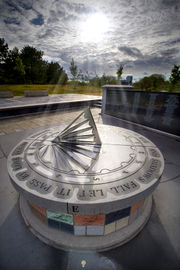
- 1960s
- On 24 January 1966 Air India Flight 101 Kanchenjunga a Boeing 707-420 (registered VT-DMN) carrying 117 people (106 passengers and 11 crew) crashed on Mont Blanc, France, on the border between France and Italy, killing all onboard. Among the dead was the noted Indian scientist, Homi J. Bhabha.
- 1970s
- On 1 January 1978 Air India Flight 855 Emperor Ashoka a Boeing 747-237B (registered VT-EBD) crashed into the Arabian Sea after takeoff from Sahar International Airport (now Chhatrapati Shivaji International Airport) in Mumbai, killing all on board (213 persons; 190 passengers, 23 crew).
- 1980s
- On 21 June 1982 Air India Flight 403 Gouri Shankar a Boeing 707-420 (registered VT-DJJ) carrying 99 passengers and 12 crew from Kuala Lumpur International Airport via Madras (now Chennai) crashed at Sahar International Airport after a heavy landing during a rainstorm. The fuselage exploded after starting a late go-around. Two crew members and 15 passengers were killed.[32][33]
- On 23 June 1985 Air India Flight 182 Emperor Kanishka a Boeing 747-237B (registered VT-EFO) was blown up in mid-air, mid-flight by a suitcase-bomb planted by Babbar Khalsa Terrorists allegedly as revenge for the Indian Government's operation on the Golden Temple on June 1984. The flight was on the first leg on its Montréal-London-Delhi-Bombay flight when it exploded off the coast of Cork, Ireland. The plane crashed into the Atlantic Ocean. All 307 passengers and 22 crew on board died.[34] After this incident Air India suspended all services to Montréal.
- 1990s
- On 7 May 1990 Air India Flight 132 Emperor Vikramaditya a Boeing 747-237B (registered VT-EBO) flying on the London-Delhi-Bombay route and carrying 215 people (195 passengers and 20 crew) touched down at Delhi's Indira Gandhi International Airport after a flight from London's Heathrow Airport. On application of reverse thrust, a failure of the no. 1 engine pylon to wing attachment caused this engine to tilt nose down. Hot exhaustion gasses caused a fire on the left wing. There were no fatalities but the aircraft was damaged beyond repair and written off.[35]
- 2000s
- On 4 September 2009, Air India Flight 829 Konark a Boeing 747-437 (registered VT-ESM) flying on the Mumbai-Riyadh route caught fire at Chhatrapati Shivaji International Airport. The fire started in number one engine while the aircraft was taxing to Runway 27 for take-off. An emergency evacuation was carried out with no injuries among the 228 people (213 passengers and 15 crew) on board.
See also
- National Aviation Company of India Limited
- Indian Airlines
- Air India Regional
- Air India Air Transport Services
References
- ↑ Air India joins Star Alliance – The Hindu
- ↑ Air India to join Star Alliance
- ↑ "Air India to join Star Alliance by March 2011-Airlines / Aviation-Transportation-News By Industry-News-The Economic Times". Economictimes.indiatimes.com. 2010-05-15. http://economictimes.indiatimes.com/news/news-by-industry/transportation/airlines-/-aviation/Air-India-to-join-Star-Alliance-by-March-2011/articleshow/5934302.cms. Retrieved 2010-06-10.
- ↑ "Air India privatisation finds three suitors". BBC News. 23 February 2001. http://news.bbc.co.uk/2/hi/business/1185716.stm. Retrieved 23 April 2010.
- ↑ "India privatisation plans near 'collapse'". BBC News. 3 September 2001. http://news.bbc.co.uk/2/hi/business/1523153.stm. Retrieved 23 April 2010.
- ↑ 6.0 6.1 "All The King’s Men". Businessworld.in. 2010-05-08. http://www.businessworld.in/bw/2010_05_08_All_The_Kings_Men.html?storyInSinglePage=true. Retrieved 2010-08-12.
- ↑ 16 Jul, 2009, 06.10AM IST, Manju V,TNN (2009-07-16). "What sent Air India crashing?". Economictimes.indiatimes.com. http://economictimes.indiatimes.com/What-sent-Air-India-crashing/articleshow/4782707.cms. Retrieved 2010-08-30.
- ↑ "Air India restructuring plans being readied". Hindu.com. 2009-07-09. http://www.hindu.com/2009/07/09/stories/2009070960801200.htm. Retrieved 2010-08-30.
- ↑ "SBI Caps prepares roadmap for Air India restructuring". Dnaindia.com. 2009-07-22. http://www.dnaindia.com/money/report_sbi-caps-prepares-roadmap-for-air-india-restructuring_1276407. Retrieved 2010-08-30.
- ↑ "AI sells 4 aircraft in Mar to tackle financial crunch". Financialexpress.com. 2009-07-29. http://www.financialexpress.com/news/AI-sells-4-aircraft-in-Mar-to-tackle-financial-crunch/495189/. Retrieved 2010-08-30.
- ↑ "Air India to use Terminal-3 as hub of operations - NDTV Profit". Beta.profit.ndtv.com. 2010-07-14. http://beta.profit.ndtv.com/news/show/air-india-to-use-terminal-3-as-hub-of-operations-82429. Retrieved 2010-08-12.
- ↑ "Flying Returns - Code Share Partners". Air India. http://www.aircanada.com/en/travelinfo/airport/codeshare.html. Retrieved 8 August 2010.
- ↑ "AirIndia - Code-Share Partners". Home.airindia.in. http://home.airindia.in/SBCMS/Webpages/Code-Share-Partners.aspx?mid=31. Retrieved 2010-08-30.
- ↑ "Air India Entry To Star Delayed By Year". Aviation Week. 2009-03-18. http://www.aviationweek.com/aw/generic/story_generic.jsp?channel=aviationdaily&id=news/IND03189.xml. Retrieved 2010-06-10.
- ↑ 25 Jan, 2008, 12.19AM IST, Chanchal Pal Chauhan,TNN (2008-01-25). "Air India to end ties with KLM, BA, Cathay". Economictimes.indiatimes.com. http://economictimes.indiatimes.com/News/News_By_Industry/Transportation/Airlines__Aviation/Air_India_to_end_ties_with_KLM_BA_Cathay/articleshow/2729344.cms. Retrieved 2010-08-30.
- ↑ [1]
- ↑ "Air India Fleet Details". http://home.airindia.in/SBCMS/Webpages/Fleet-Details1.aspx?MID=196. Retrieved 2009-02-05.
- ↑ "NACIL Fleet (As on 1st February 2010)". Home.airindia.in. 2010-08-01. http://home.airindia.in/SBCMS/Webpages/Fleet-Details1.aspx?MID=196#. Retrieved 2010-08-30.
- ↑ "Air India - Details and Fleet History - Planespotters.net Just Aviation". Planespotters.net. http://www.planespotters.net/Airline/Air-India. Retrieved 2010-06-10.
- ↑ "Air India Fleet". Airfleets. http://airfleets.net/flottecie/Air%20India.htm. Retrieved 2010-06-10.
- ↑ "Air India Fleet - Wikipedia, the free encyclopedia". En.wikipedia.org. http://en.wikipedia.org/wiki/Air_India_Fleet. Retrieved 2010-06-10.
- ↑ "AirIndia - 2006 New Boeing 777 Aircraft". Home.airindia.in. 2006-09-12. http://home.airindia.in/SBCMS/Webpages/2006-New-Boeing-777-Aircraft.aspx. Retrieved 2010-06-10.
- ↑ "Business / Briefly : Air India bags Awaz consumer awards 2006". The Hindu. 2006-07-21. http://www.hindu.com/2006/07/21/stories/2006072102901809.htm. Retrieved 2010-08-30.
- ↑ 24.0 24.1 24.2 24.3 24.4 24.5 "AirIndia - Backgrounder- Note". Home.airindia.in. http://home.airindia.in/SBCMS/Webpages/Backgrounder-Note.aspx?MID=196. Retrieved 2010-06-10.
- ↑ "AirIndia - Air India Cargo wins ‘CARGO AIRLINE OF THE YEAR’ Award". Home.airindia.in. 2009-04-29. http://home.airindia.in/SBCMS/Webpages/cargo-wins.aspx. Retrieved 2010-06-10.
- ↑ "Air India,History of Air India,Air India Flight Services,Air India International,Passenger Operations,Awards in Air India". Thisismyindia.com. http://www.thisismyindia.com/air-line/airindia.html. Retrieved 2010-06-10.
- ↑ "UN Environment Award for Air India – India Airline News, Airport developments, Aviation, A380, B787, Kingfisher, Deccan, Jet Airways, Air India, Indian Airlines, Spicejet". Indiaaviation.aero. http://indiaaviation.aero/news/airline/4922/59/UN-Environment-Award-for-Air-India. Retrieved 2010-08-30.
- ↑ "Accident Rates By Airline". AirDisaster.com. http://www.airdisaster.com/statistics/.
- ↑ "MALABAR PRINCESS". http://ghmorel.free.fr/malpag/synus.html. Retrieved 2009-06-17.
- ↑ "The "Malabar Princess" Catastrophe". http://www.montblanc.to/uk/glacier/texte4.html. Retrieved 2009-06-17.
- ↑ "ASN Aircraft accident Lockheed L-749A Constellation VT-DEP Great Natuna Islands". Aviation-safety.net. http://aviation-safety.net/database/record.php?id=19550411-1. Retrieved 2010-06-10.
- ↑ "Accident Database: Accident Synopsis 06221982". Airdisaster.com. 1982-06-22. http://www.airdisaster.com/cgi-bin/view_details.cgi?date=06221982®=VT-DJJ&airline=Air+India. Retrieved 2010-08-30.
- ↑ "Fatal Events Since 1970 for Air India". Airsafe.com. http://www.airsafe.com/events/airlines/ain.htm. Retrieved 2010-08-30.
- ↑ "Indepth: Air India". CBC News. http://www.cbc.ca/news/airindia/. Retrieved 2007-05-08.
- ↑ "ASN Aircraft accident Boeing 747-237B VT-EBO Delhi-Indira Gandhi International Airport (DEL)". Aviation-safety.net. http://aviation-safety.net/database/record.php?id=19900507-0. Retrieved 2010-06-10.
External links
|
|||||
|
||||||||||||||||||||||||||
|
||||||||||||||||||||||||||||||||||||||||||||||||||||||||||||||||||
